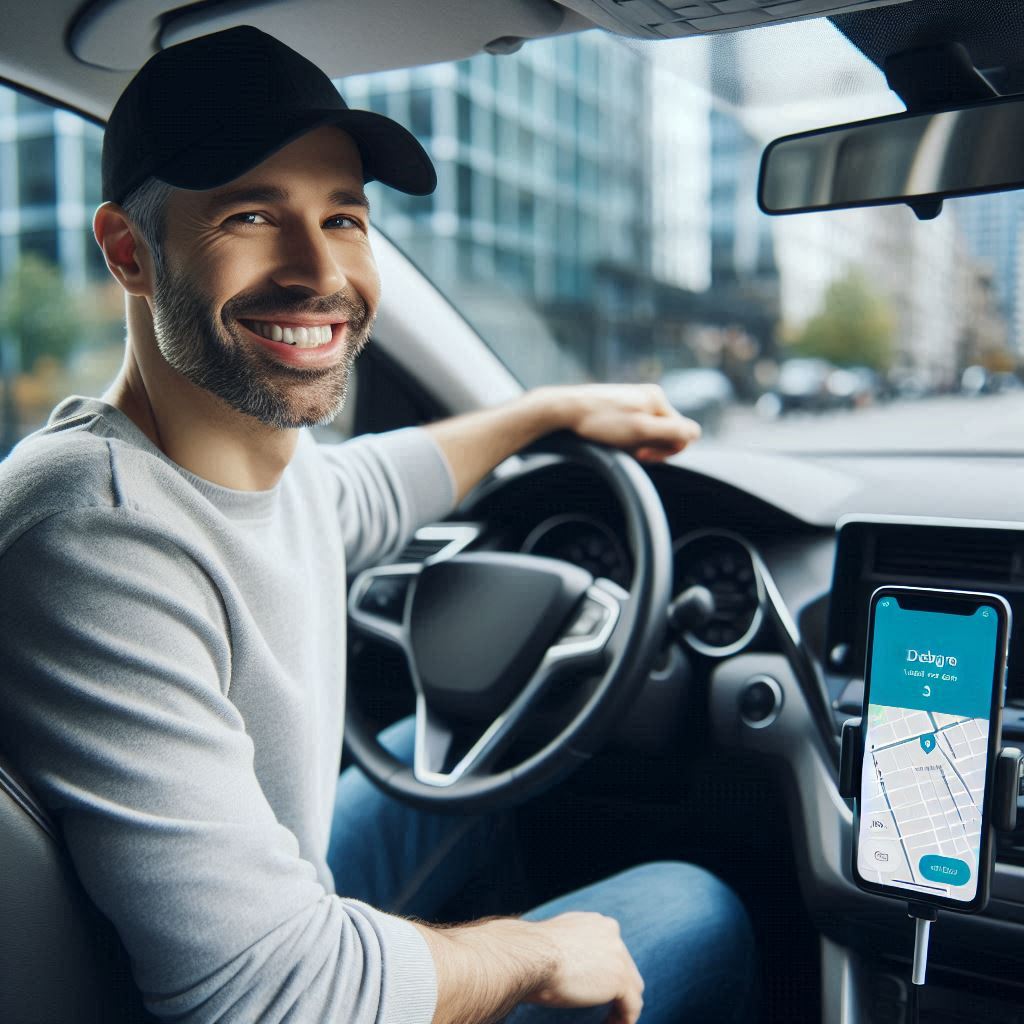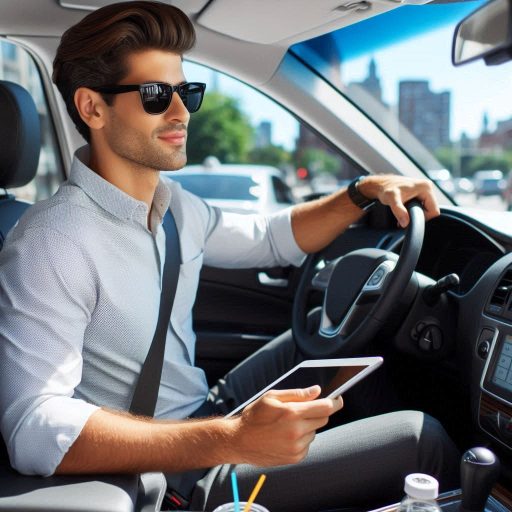Introduction
Rideshare services have revolutionized the transportation industry.
They offer convenient and cost-effective alternatives to traditional taxi services.
By connecting passengers with drivers through mobile apps, these services streamline the entire process.
Passengers can request rides with just a few taps on their smartphones.
Rideshare platforms, such as Uber and Lyft, dominate the market.
They enable users to select vehicles based on their preferences and budget.
This flexibility makes ridesharing appealing to a wide range of customers.
Rideshare services also promote economic opportunities for drivers.
Individuals can earn money by using their vehicles to provide rides.
This gig economy model allows drivers to set their own hours and work as much or as little as they want.
Safety remains a priority in the ridesharing industry.
Most platforms implement safety features, such as driver background checks and in-app emergency options.
These measures enhance passenger confidence in choosing rideshare services.
Rideshare services offer convenience and flexibility.
They connect passengers with drivers while ensuring safety and promoting economic opportunities.
Understanding these aspects helps users appreciate the value of rideshare services in today‘s transportation landscape.
The Ridehailing Platform
Popular rideshare platforms (e.g. Uber, Lyft)
Rideshare platforms like Uber and Lyft revolutionized the transportation industry.
These platforms connect drivers with passengers through a user-friendly mobile app.
Understanding how these platforms work is essential for all rideshare drivers.
How drivers use the platform to receive ride requests
When drivers sign up, they create an account on the platform.
They provide necessary information, including their vehicle details and driver‘s license.
Once approved, drivers can start receiving ride requests from passengers nearby.
The platform displays these requests on their app, allowing drivers to accept or decline rides.
The ridehailing platform uses GPS technology to connect drivers and passengers efficiently.
GPS helps locate nearby drivers when a passenger requests a ride.
This technology allows the platform to calculate the best pickup and drop-off locations.
Drivers benefit from precise directions to minimize travel time and enhance passenger satisfaction.
Upon accepting a ride request, the driver receives the passenger’s location.
The app then provides turn-by-turn navigation to the pickup point.
After picking up the passenger, the driver follows the app’s directions to the destination.
This process simplifies the entire ride experience for both parties.
Importance of GPS technology in connecting drivers and passengers
Understanding the platform‘s features is vital for drivers.
The app includes important information, such as the estimated time of arrival and fare estimate.
This transparency helps manage passenger expectations and improves overall service quality.
Drivers can also access their earnings and ride history through the app, making it easier to track performance.
Rideshare platforms often offer safety features for both drivers and passengers.
These include in-app emergency contacts and ride-sharing details.
Drivers can share their trip details with trusted contacts for added security.
This focus on safety builds trust and confidence among passengers.
Moreover, drivers can use the platform’s feedback system to improve their services.
After each ride, passengers can rate their experience and leave comments.
Drivers can learn from this feedback, helping them enhance their skills and service quality.
Understanding the ridehailing platform is crucial for all rideshare drivers.
The combination of user-friendly features and GPS technology makes the experience seamless.
Drivers must familiarize themselves with these platforms to provide excellent service.
By leveraging the platform’s capabilities, drivers can ensure safer, more efficient rides for passengers.
Embracing these technologies allows drivers to thrive in the competitive rideshare market.
Read: Understanding Nail Disorders: A Technician‘s Guide
Driver Apps and Tools
Rideshare drivers rely heavily on mobile apps to manage their daily operations.
These apps provide essential features that enhance the driving experience and improve overall efficiency.
Overview of the mobile apps used by rideshare drivers
Popular rideshare platforms like Uber and Lyft offer dedicated driver apps.
These apps are designed to help drivers navigate their tasks seamlessly.
Drivers can easily download these apps from app stores.
Once installed, they can log in to start receiving ride requests.
Features of driver apps such as navigation, payment processing, and rating systems
Driver apps include several key features that support daily operations.
One of the most important features is navigation.
The app provides turn-by-turn directions to ensure drivers reach their passengers and destinations efficiently.
Drivers can also choose the fastest route, which saves time and fuel.
Another essential feature is payment processing.
The app allows drivers to receive payments directly from passengers.
Once a ride is completed, the app calculates the fare automatically.
Drivers can track their earnings daily, weekly, or monthly, helping them manage their finances effectively.
Rating systems are also integrated into these apps.
After each ride, passengers can rate their experience and provide feedback.
This feedback helps drivers improve their services and maintain high standards.
A good rating can lead to more ride requests and increased earnings.
Importance of efficiency and user-friendly interfaces for drivers
Efficiency is crucial for rideshare drivers.
The more rides they complete, the higher their earnings.
Therefore, a user-friendly app interface is essential.
Drivers need to access features quickly without distractions.
An intuitive layout allows them to navigate the app effortlessly, focusing on driving safely.
Moreover, timely updates and notifications keep drivers informed.
These updates can include ride requests, passenger locations, and potential cancellations.
Drivers can respond quickly to changing situations, enhancing their service quality.
The ability to manage multiple features within the app streamlines operations.
For example, drivers can switch between navigation and payment processing easily.
This seamless integration ensures drivers stay organized and efficient.
In addition to core features, some driver apps offer additional tools.
These may include vehicle maintenance reminders or tips for improving customer service.
Drivers can leverage these resources to enhance their overall performance.
Driver apps and tools are essential for rideshare drivers.
They offer navigation, payment processing, and rating systems that streamline operations.
A user-friendly interface enhances efficiency, allowing drivers to focus on providing excellent service.
By mastering these tools, drivers can improve their earnings and enhance the passenger experience.
Embracing technology ensures success in the competitive rideshare market.
Read: How to Deal with Pet Grooming Allergies
Navigation and Mapping Technology
Navigation and mapping technology play a crucial role in the rideshare industry.
Drivers depend on accurate GPS systems and real-time traffic updates to navigate efficiently.
Role of GPS and mapping technology in ridesharing
GPS technology helps drivers find the quickest routes to their destinations.
Rideshare apps integrate GPS to provide precise directions.
This technology eliminates the need for paper maps and reduces the chances of getting lost.
Accurate GPS information allows drivers to arrive promptly, enhancing passenger satisfaction.
Mapping technology also offers detailed information about local roads and neighborhoods.
Drivers can access street layouts, points of interest, and traffic regulations through the app.
This feature helps drivers familiarize themselves with new areas and improves their overall service.
How drivers rely on accurate maps and real-time traffic updates
Drivers rely heavily on accurate maps for navigation.
The mapping systems in rideshare apps are constantly updated.
This ensures drivers have the latest information about road conditions and closures.
Real-time traffic updates allow drivers to avoid congested areas and accidents.
Consequently, they can adjust their routes accordingly.
For instance, if a traffic jam occurs, the app can suggest alternative routes.
This capability minimizes delays and keeps passengers informed.
Drivers appreciate being able to share updated ETAs with their passengers, which enhances communication and trust.
Importance of technology in helping drivers choose the best routes
The technology behind rideshare navigation not only saves time but also reduces fuel costs.
By choosing efficient routes, drivers can conserve fuel and maximize earnings.
A well-planned route also minimizes wear and tear on the vehicle, leading to lower maintenance costs.
Moreover, advanced mapping technology can predict traffic patterns based on historical data.
This feature enables drivers to plan their routes strategically, even before accepting a ride request.
Drivers can choose times to avoid heavy traffic, optimizing their working hours.
In addition to optimizing routes, mapping technology provides insights into passenger pick-up and drop-off locations.
Drivers can quickly locate busy areas, such as airports or event venues.
This knowledge helps drivers position themselves strategically to receive more ride requests.
Safety is another critical aspect of navigation technology.
Accurate GPS helps drivers navigate safely, reducing the risk of accidents.
Additionally, the ability to share their location with passengers provides reassurance to both parties.
Navigation and mapping technology are vital for rideshare drivers.
GPS systems and real-time traffic updates enhance efficiency and improve service quality.
By relying on this technology, drivers can choose the best routes, save time, and reduce costs.
Embracing these tools allows drivers to thrive in the competitive rideshare industry.
Read: Creating a Comfortable Atmosphere in Your Nail Salon

Communication Tools
Effective communication tools are essential for rideshare drivers.
They enhance the overall experience for both drivers and passengers.
Clear communication ensures smooth interactions and promotes safety during rides.
Communication tools used by rideshare drivers
Rideshare platforms provide various communication tools for drivers and passengers.
In-app messaging allows users to communicate without sharing personal phone numbers.
This feature protects the privacy of both parties while facilitating essential conversations.
Phone calls are another vital communication tool.
Drivers can contact passengers directly through the app.
This function is particularly useful for confirming pick-up locations or addressing any last-minute changes.
Passengers can also reach out to drivers if they need assistance.
Some rideshare apps even offer automated messages to inform passengers about driver details.
This includes the driver‘s name, vehicle type, and estimated arrival time.
These automated messages reduce confusion and enhance transparency.
Importance of clear communication between drivers and passengers
Clear communication fosters a positive relationship between drivers and passengers.
It helps establish expectations and reduces anxiety during the ride.
For instance, drivers can update passengers about delays or traffic issues promptly.
By communicating effectively, drivers can address any concerns or preferences passengers may have.
This includes preferences for music volume or air conditioning settings.
Such attentiveness can significantly enhance the passenger‘s experience.
Additionally, clear communication can help prevent misunderstandings.
For example, confirming the exact pick-up location minimizes confusion.
This practice ensures that passengers feel secure and valued.
How technology enhances the overall ridesharing experience
Technology plays a vital role in enhancing communication.
Real-time notifications inform drivers about ride requests and changes.
This immediacy allows drivers to respond quickly and efficiently.
In-app ratings and feedback systems provide insights into communication effectiveness.
After the ride, passengers can rate their experience.
This feedback helps drivers improve their communication skills for future rides.
Moreover, some platforms offer translation features for multilingual communication.
This capability ensures that drivers can communicate with passengers who speak different languages.
It promotes inclusivity and broadens the customer base.
By utilizing these communication tools, drivers can create a welcoming environment.
Passengers who feel comfortable are more likely to leave positive reviews.
This feedback directly impacts a driver‘s reputation and success in the rideshare industry.
Communication tools are crucial for rideshare drivers.
In-app messaging and phone calls facilitate clear and effective interactions.
Such communication enhances the ridesharing experience for both drivers and passengers.
Embracing technology in communication fosters positive relationships, leading to increased satisfaction and repeat business.
Read: How to Create a Pet-Friendly Grooming Environment
Transform Your Career Today
Unlock a personalized career strategy that drives real results. Get tailored advice and a roadmap designed just for you.
Start NowSee Related Content: Understanding the Real Estate Agent Job Market
Safety and Security Features
Safety and security features are vital in the rideshare industry.
They protect both drivers and passengers during rides.
Rideshare companies prioritize implementing technology that ensures a secure experience.
Overview of safety features in rideshare apps
Rideshare apps incorporate various safety features to enhance security.
Driver background checks are one crucial aspect.
Companies conduct thorough background screenings before allowing drivers to join their platforms.
These checks include criminal history, driving records, and identity verification.
Emergency buttons are another essential safety feature.
Passengers can easily access these buttons within the app during rides.
Activating the emergency button alerts local authorities and shares the rider‘s location.
This feature provides peace of mind for both passengers and drivers.
Real-time ride tracking is also a vital safety feature.
Passengers can share their trip details with friends or family.
This sharing helps ensure someone is aware of their whereabouts during the ride.
How technology is used to ensure the safety of both drivers and passengers
Technology plays a significant role in enhancing safety.
In-app GPS tracking allows both drivers and passengers to monitor routes in real time.
This feature promotes transparency and accountability during rides.
Additionally, rideshare apps often use two-way ratings systems.
After a ride, both drivers and passengers can rate each other.
This system encourages respectful behavior and helps identify any issues.
Some apps also provide safety tips for drivers and passengers.
These tips educate users about safe practices during rides.
Examples include verifying the driver’s identity and sharing ride details with trusted contacts.
Importance of trust and security in the ridesharing industry
Trust is crucial in the rideshare industry.
Passengers must feel secure in getting into a vehicle with a stranger.
Drivers also need assurance that their passengers are safe and responsible.
Effective safety features foster this trust.
When passengers see that a company prioritizes their safety, they are more likely to use the service.
Similarly, drivers feel more secure when they know their platform implements safety measures.
Moreover, a strong focus on safety can enhance a company‘s reputation.
Positive experiences lead to better reviews and repeat customers.
Trustworthy rideshare services can attract more drivers, creating a robust community.
Safety and security features are essential in rideshare apps.
Background checks, emergency buttons, and real-time tracking ensure a safe environment.
Technology enhances these features, promoting transparency and accountability.
Trust and security are crucial for success in the rideshare industry, benefiting both drivers and passengers alike.
Companies that prioritize safety build strong relationships, leading to long-term success.
You Might Also Like: Job Outlook for Service Industry Office Clerks
Delve into the Subject: How to Handle Lockouts Without Panicking
Data and Analytics
Rideshare companies leverage data and analytics to enhance their services.
This approach helps improve driver performance and overall customer satisfaction.
By collecting and analyzing data, companies can optimize operations effectively.
How rideshare companies collect and analyze data
Rideshare companies gather various data points from their platforms.
They track ride requests, driver locations, and passenger ratings.
Each trip generates valuable information about driver performance and passenger preferences.
This data collection occurs in real-time, allowing companies to respond quickly.
They use GPS technology to monitor driver routes and traffic patterns.
By analyzing this data, companies identify trends and adjust their services accordingly.
Data analytics tools help process this information efficiently.
Companies employ algorithms to analyze ride patterns, peak hours, and passenger demand.
This analysis enables rideshare companies to make data-driven decisions.
How data-driven insights help improve services and driver performance
Data-driven insights directly impact service quality and driver performance.
Companies can identify the most popular routes and times for rides.
This knowledge allows drivers to maximize their earnings during peak demand periods.
Additionally, companies analyze driver performance metrics.
They evaluate factors such as ride completion rates, cancellations, and customer feedback.
These insights help identify areas for improvement, providing targeted training and support for drivers.
Furthermore, companies can personalize the passenger experience.
By analyzing user preferences and previous rides, they can recommend tailored services.
This personalization enhances customer satisfaction and encourages repeat business.
Importance of using technology to optimize operations and customer satisfaction
Technology plays a crucial role in optimizing operations.
Advanced data analytics tools enable companies to streamline processes and improve efficiency.
For example, they can automate surge pricing to manage high demand.
Moreover, technology helps enhance communication between drivers and passengers.
Real-time data sharing allows drivers to navigate efficiently.
Passengers receive accurate arrival times, reducing frustration and improving their experience.
Companies can also identify potential issues before they escalate.
Data analysis highlights patterns in complaints or low ratings.
By addressing these concerns proactively, companies improve service quality and customer satisfaction.
Data and analytics are vital for rideshare companies.
They collect and analyze various data points to enhance services and driver performance.
Data-driven insights lead to personalized experiences and operational efficiencies.
Utilizing technology optimizes both operations and customer satisfaction.
Companies that embrace data analytics build a stronger foundation for growth and success in the rideshare industry.
Conclusion
In this blog post, we explored the critical role of technology in the ridesharing industry.
We discussed various tools and platforms that enhance the driver and passenger experience.
Key points included the importance of ridehailing platforms, navigation technology, and communication tools.
We emphasized how GPS and mapping technology connect drivers and passengers efficiently.
Additionally, we highlighted the significance of safety features that protect both parties during rides.
Data analytics plays a vital role in optimizing services and improving customer satisfaction.
Technology has transformed ridesharing into a convenient and safe option for transportation.
It streamlines processes, enhances communication, and ensures safety through various features.
Drivers and passengers can rely on these advancements for an optimal experience.
As rideshare users, we should appreciate the technology that enables seamless rides.
Understanding the systems in place enhances our awareness of the service’s value.
Whether you’re a driver or a passenger, recognizing the role of technology is crucial.
Technology shapes the ridesharing landscape, making it safer and more efficient.
Let‘s embrace these innovations for a better ridesharing experience.




